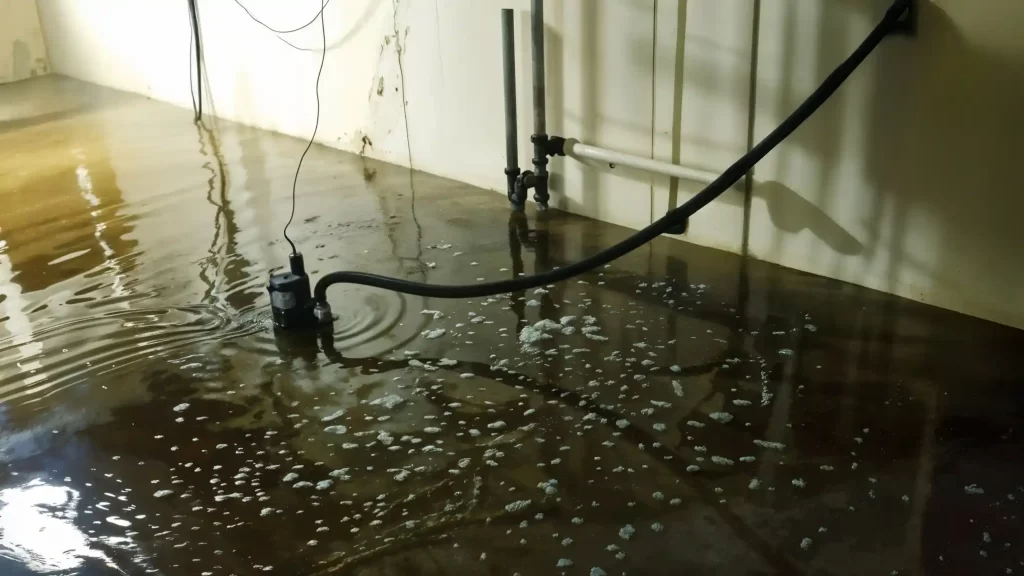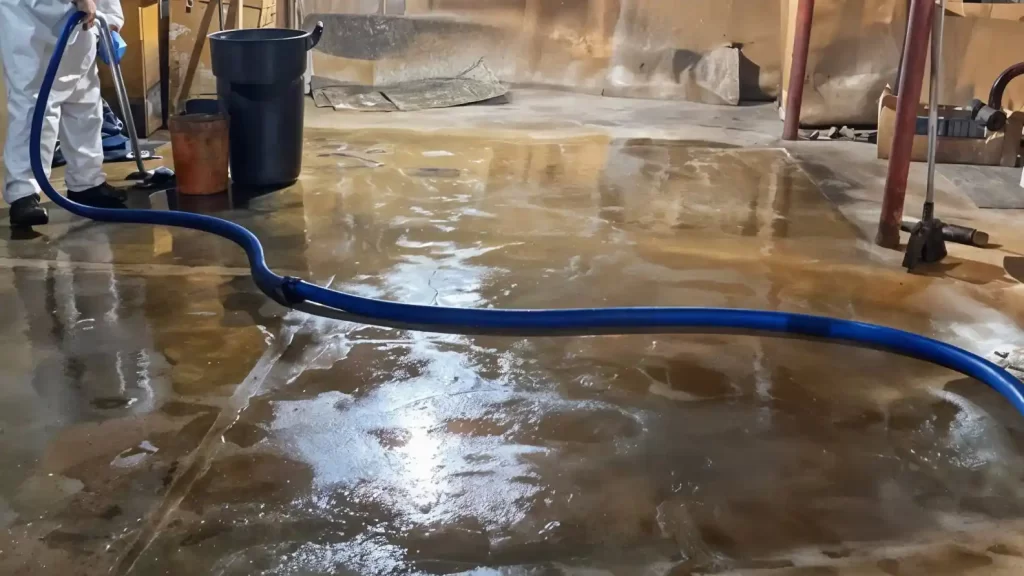A flooded basement is every homeowner’s nightmare. Whether caused by heavy rain, burst pipes, or a malfunctioning sump pump, standing water in your basement can quickly lead to structural damage, ruined belongings, and even health hazards from mold growth. When disaster strikes, one of the first questions homeowners ask is: “How much does it really cost to remove water from a basement?”
The answer isn’t always simple. Several factors—ranging from the amount of water to the type of damage—determine the final bill. Let’s break it down so you know what to expect, and why calling a trusted professional like Semper Fi in Yuma, AZ can save you money and stress in the long run.

1. The Factors That Affect Water Removal Costs
No two water damage incidents are exactly alike, which means the cost can vary widely. Some of the biggest factors include:
Extent of the Flooding
- Minor seepage (just a few inches of water) may only require pumping, drying, and minor cleaning.
- Moderate flooding (several inches to a foot) often involves water extraction, drywall removal, and carpet replacement.
- Severe flooding (multiple feet of water) can damage electrical systems, HVAC units, and structural components, driving costs up significantly.
Type of Water
Not all water is equal when it comes to cleanup:
- Clean water (from a broken supply line) is the least expensive to remove.
- Gray water (from appliances like washing machines) requires more care due to potential contaminants.
- Black water (from sewage backups or floodwater) is the most hazardous and costly, requiring specialized cleaning, disinfection, and sometimes demolition.
Size of the Basement
A 500-square-foot basement will cost far less to dry and restore than a 1,500-square-foot space. More square footage means more equipment, labor, and time.
Time Before Response
The longer water sits, the more damage it causes. Immediate removal is always cheaper than waiting days, as mold remediation and structural repairs may become necessary.
2. Typical Price Ranges
While costs vary, here’s what homeowners can generally expect:
- Water extraction only: $500 – $1,500
- Drying and dehumidification: $1,000 – $3,000
- Carpet removal and replacement: $1,500 – $4,000
- Full basement restoration after severe flooding: $5,000 – $15,000+
These are averages, and actual costs depend on the specific situation. For example, a small clean-water leak that’s addressed immediately could cost under $1,000, while a large-scale sewage backup might exceed $20,000.
3. Additional Expenses to Consider
Beyond the basics of water extraction and drying, you may encounter additional costs such as:
- Mold remediation: If mold begins to grow, expect to pay $500 – $6,000 depending on severity.
- Structural repairs: Warped wood, crumbling drywall, or compromised foundations can add thousands to the bill.
- Electrical/HVAC repairs: If systems are submerged, professional replacement may be required.
- Content restoration: Cleaning or replacing furniture, electronics, and personal items can also be costly.
It’s important to get a thorough inspection to avoid surprise expenses down the road.
4. Does Insurance Cover It?
One of the biggest concerns homeowners have is whether their insurance will help cover the costs. The answer depends on the cause of the flooding:
- Burst pipes or appliance leaks: Often covered under standard homeowners’ policies.
- Groundwater flooding from storms: Typically not covered unless you have a separate flood insurance policy.
- Sewage backups: May be covered if you’ve added a specific rider to your policy.
Before disaster strikes, review your policy carefully and consider additional coverage if you live in a flood-prone area.
5. Why Hiring a Professional is Worth It
Some homeowners consider tackling water removal on their own to save money. While DIY methods can help in minor cases, professional help is almost always the safer and more cost-effective route. Here’s why:
- Speed: Professionals have industrial pumps and dryers that can remove water in hours—not days.
- Safety: They know how to handle contaminated water without risking your health.
- Prevention: Experts can identify hidden damage behind walls or under flooring that DIY efforts might miss.
- Restoration: Beyond just drying, pros can restore your basement to pre-loss condition.
6. Why Choose Semper Fi in Yuma, AZ?
When disaster strikes in Yuma, homeowners trust Semper Fi—the area’s premier water damage restoration company. Their experienced team specializes in rapid water extraction, drying, and full-scale restoration. With a commitment to integrity, efficiency, and customer satisfaction, Semper Fi doesn’t just remove water—they restore peace of mind.
Whether you’re facing a minor leak or a catastrophic basement flood, their 24/7 emergency response ensures help is always just a phone call away. Choosing Semper Fi means choosing a local team that understands Yuma’s unique climate challenges and has the expertise to handle any water damage scenario.

Final Thoughts
So, how much does it really cost to remove water from a basement? The truth is, it depends—on the size of your basement, the type of water, the extent of damage, and how quickly you act. Costs can range from a few hundred dollars for small, clean-water incidents to tens of thousands for severe, contaminated floods with structural damage.
What’s clear, however, is that acting quickly and calling a trusted professional like Semper Fi in Yuma can make all the difference. Not only can you save money by preventing further damage, but you’ll also protect your home, health, and peace of mind.
FAQ
1. How much does it cost to remove water from a basement?
Costs vary depending on the amount of water, type of water (clean, gray, or black), and extent of damage. On average, it can range from $500 for minor extraction to over $15,000 for full restoration.
2. What factors influence the cost the most?
The main factors are:
- Extent of flooding (inches vs. several feet)
- Type of water (clean, gray, or contaminated black water)
- Size of the basement
- Time before cleanup begins (mold and structural damage increase costs)
3. Does homeowners’ insurance cover basement water removal?
It depends. Burst pipes and appliance leaks are often covered, but groundwater flooding usually requires a separate flood insurance policy. Always check with your provider before disaster strikes.
4. What’s the difference between clean, gray, and black water?
- Clean water: From a supply line, usually safe and cheapest to clean.
- Gray water: From appliances, may contain contaminants.
- Black water: From sewage or floodwater, highly hazardous and most expensive to remediate.
5. Can I remove basement water myself to save money?
For small leaks, DIY pumping and fans may help. But for larger floods or contaminated water, professional services are essential to prevent hidden damage, mold growth, and health risks.
6. How long does it take to dry out a basement after flooding?
With professional equipment, it usually takes 24–72 hours to fully dry a basement. Severe cases with structural damage or mold may take longer.
7. What additional costs should I expect beyond water extraction?
Possible extras include:
- Mold remediation ($500 – $6,000)
- Structural repairs (varies widely)
- Electrical/HVAC repairs if systems are damaged
- Content cleaning/replacement for belongings
8. Is it worth calling a professional water restoration company?
Absolutely. Professionals like Semper Fi in Yuma, AZ have the expertise, industrial equipment, and safety protocols to ensure your basement is not just dried, but fully restored. DIY solutions often leave hidden damage that costs more later.
9. How can I prevent basement flooding in the future?
- Install or maintain a sump pump
- Seal foundation cracks
- Clean gutters and downspouts
- Ensure proper grading around your home
- Consider a backup generator for storm-related outages
10. Why choose Semper Fi for basement water removal in Yuma?
Semper Fi is the premier water damage restoration company in Yuma, AZ, known for:
- 24/7 emergency response
- Advanced drying and extraction equipment
- Expertise in both minor and major restoration projects
- A commitment to restoring homes quickly and safely


